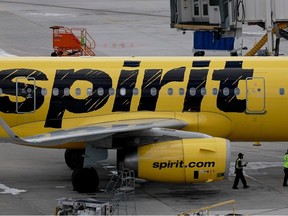
Spirit Airlines updated its dress code this week with more descriptive and restrictive rules, warning passengers that showing too much skin – or a crass tattoo – could get them banned from boarding or removed from a flight.
Recommended Videos
As of Wednesday, the ultra-low-cost carrier will prohibit passengers from flying if they are wearing revealing or offensive attire. In its revised contract of carriage, a legal agreement between a carrier and a customer, Spirit states that it can refuse service to passengers who show up “barefoot or are inadequately clothed,” such as wearing items that are see-through or expose their private parts.
The airline also will not tolerate garments or body art deemed “lewd, obscene, or offensive in nature.”
“Spirit is not saying you have to wear a ball gown or a tuxedo to fly on their planes,” said Henry H. Harteveldt, a travel industry analyst and president of Atmosphere Research Group. “By all means be comfortable, but don’t wear anything that would make someone feel unwelcome, that has a hate message or is vulgar or pornographic.”
The more stringent dress code is one of several conduct and behavior regulations that, if flouted, could result in a missed flight – and public scene. The list also includes appearing intoxicated or under the influence of drugs, refusing to wear a seat belt or emitting a strong odor unrelated to a disability.
Depending on the circumstances, the flight attendant may ask the passenger to remove or cover up the objectionable article. If the issue escalates and the flier is given the boot, the airline will not refund the fare, according to the contract of carriage.
Spirit did not reply to a request for comment, nor has the airline explained what prompted it to bulk up its dress code. However, Spirit recently experienced two wardrobe-related incidents.
In October, two women claimed they were pulled from their flight from Los Angeles to New Orleans because of their crop tops. The friends, who were traveling with a small child, said they had removed their sweaters because of the warm temperature inside the cabin.
Then, on Jan. 15, a San Antonio man said the airline booted him for wearing a hoodie adorned with a word that could be interpreted as an expletive. A passenger captured the heated exchange on video. The man disembarked and caught another Spirit flight from LAX.
“Remember that when we fly, we are traveling in a public space,” Harteveldt said. “So be thoughtful of others in the airport as well as on the plane.”
With casual travel attire the norm, confrontations over questionable outfits are becoming more common.
Last year, Delta removed a woman named Lisa Archbold from a plane in Salt Lake City for allegedly not wearing a bra under her loose, white shirt. According to her lawyer, a gate agent told her if she covered up, she could fly.
Delta’s contract of carriage says it can refuse service when a “passenger’s conduct, attire, hygiene or odor creates an unreasonable risk of offense or annoyance to other passengers.”
Another clash over clothing occurred later that year. In San Francisco, a Delta flight crew member stopped a Marine Corps veteran from boarding allegedly because of her T-shirt, which raised awareness for servicemember suicide. She was eventually allowed to resume her travels.
The First Amendment protects an individual’s freedom of speech and expression. However, private companies can enact codes of conduct for the greater good of their customers. Most restaurants, for instance, prohibit bare feet, and some nightclubs don’t allow athletic wear and baseball caps.
Unsure about the appropriateness of your travel outfit? Check the airline’s contract of carriage. Or use Harteveldt’s test: “Would you wear that if you were going to confession or visiting a friend in the hospital?”